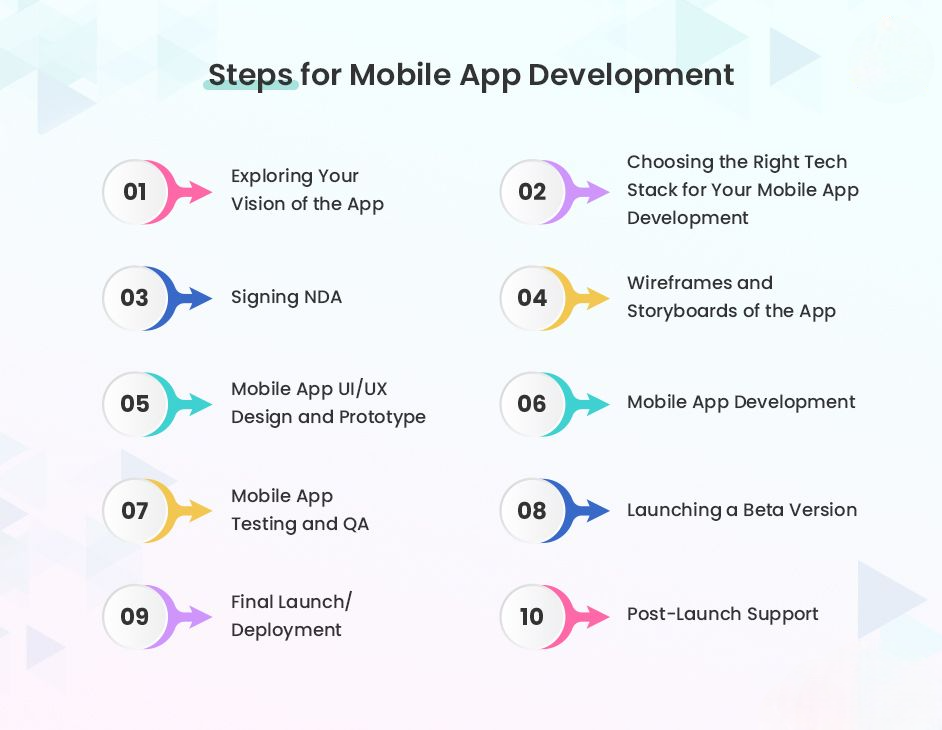I. Introduction
In today’s rapidly evolving digital landscape, Mobile App Development has emerged as a cornerstone for businesses aiming to thrive in the digital era. With billions of smartphone users worldwide and an increasingly competitive app market, the need for effective strategies in mobile app development has never been more crucial. As businesses vie for users’ attention and engagement, mastering the art of app development becomes imperative for success. In this blog, we delve into the importance of mobile app development, shed light on the fiercely competitive nature of the app market, and preview key strategies essential for navigating this dynamic landscape. If you want to develop a AI based mobile application, join Appinventers as we explore proven strategies to conquer the challenges and unlock the opportunities in mobile app development
II. Understanding the Mobile App Development Landscape

A. Current Trends and Statistics
In today’s digital age, mobile usage continues to skyrocket, with an ever-increasing number of users relying on smartphones for various tasks. Recent statistics highlight the pervasive influence of mobile devices in our daily lives, underscoring the importance of Mobile App Development. With billions of app downloads recorded annually, the app market remains highly competitive, presenting both opportunities and challenges for developers.
Moreover, emerging technologies such as Artificial Intelligence (AI) integration, Augmented Reality (AR) and Virtual Reality (VR) experiences, and Internet of Things (IoT) connectivity are reshaping the mobile app landscape. These trends are not only revolutionizing user interactions but also opening up new avenues for innovation and user engagement. Developers must stay abreast of these advancements to leverage their full potential and stay ahead of the curve in app development.
B. Importance of User Experience (UX)
User Experience (UX) plays a pivotal role in the success of mobile apps. Beyond just functionality, the overall experience that users have while interacting with an app significantly influences their satisfaction and loyalty. A well-crafted UX design can differentiate an app from its competitors and foster user engagement and retention.
Key elements of good UX design include usability, accessibility, and aesthetics. Usability ensures that the app is intuitive and easy to navigate, allowing users to accomplish tasks efficiently. Accessibility ensures that the app is inclusive and can be used by individuals with diverse needs and abilities. Aesthetics focus on the visual appeal of the app, creating an engaging and immersive experience for users. By prioritizing UX design and focusing on these essential elements, developers can create mobile apps that not only meet users’ needs but also exceed their expectations, leading to greater success and satisfaction.
III. Key Phases of Mobile App Development

A. Pre-Development Phase
Before diving into the development process, thorough market research and analysis are essential steps to ensure the success of a mobile app. This phase involves delving deep into the target market to identify key demographics and competitors. By understanding user preferences and pain points, developers can tailor their app to meet specific needs effectively.
Additionally, the conceptualization and planning stage are crucial for laying the foundation of the app. Brainstorming sessions help generate innovative ideas and features that align with the research insights. Developing a comprehensive project plan outlining timelines, resources, and goals ensures clarity and focus throughout the development process.
B. Development Phase
Choosing the right development approach is a critical decision that developers must make based on project requirements and objectives. Native, hybrid, and cross-platform development options each have their advantages and limitations, and careful consideration is necessary to select the most suitable approach.
Moreover, implementing Agile development methodology allows for flexible and iterative development, enabling teams to respond quickly to changing needs and feedback. Prioritizing features ensures that the most valuable functionalities are developed first, maximizing the app’s potential for success.
C. Post-Development Phase
After the app is developed, thorough testing and quality assurance are essential to identify and address any bugs or performance issues. Conducting extensive testing across various devices and platforms ensures a seamless user experience upon launch.
Once the app is ready for deployment, planning a strategic launch strategy is crucial for gaining traction in the app market. App store optimization (ASO) plays a significant role in improving visibility and driving downloads. Monitoring user feedback and analytics post-launch allows developers to optimize app performance and engagement continuously.
By following these key phases of Mobile App Development, developers can effectively navigate the complexities of the process and increase the likelihood of creating a successful and impactful app.
IV. Strategies for Mobile App Success
A. User-Centric Approach
Adopting a user-centric approach is fundamental to the success of any mobile app. Prioritizing user feedback and leveraging user behavior analytics allow developers to gain valuable insights into user preferences and pain points. By iteratively refining the app based on this feedback, developers can create a more intuitive and engaging user experience.
Furthermore, implementing personalization features adds a layer of customization that enhances user engagement and retention. By tailoring content and experiences to individual users’ interests and behaviors, developers can create a more meaningful and personalized app experience, fostering long-term user loyalty.
B. Monetization Strategies
Monetization is a crucial aspect of mobile app success, but it must be approached strategically to strike a balance between revenue generation and user satisfaction. Exploring various monetization models such as freemium, subscription, and in-app purchases allows developers to diversify revenue streams and cater to different user preferences.
However, it’s essential to prioritize providing value to users alongside revenue generation. Apps that offer tangible benefits and a positive user experience are more likely to retain users and drive long-term success. Balancing monetization efforts with delivering value ensures sustainable growth and fosters a loyal user base.
C. Continuous Improvement and Updates
The journey towards mobile app success doesn’t end with the initial launch; it requires ongoing dedication to continuous improvement and updates. Establishing a roadmap for regular updates and feature enhancements ensures that the app remains relevant and competitive in the ever-evolving app market.
Monitoring app performance metrics and gathering user feedback are essential components of this process. By analyzing user behavior and app usage patterns, developers can identify areas for improvement and prioritize updates accordingly. This iterative approach to app development allows developers to respond quickly to user needs and preferences, ultimately driving app success.
V. Conclusion
Mastering mobile app development requires a holistic approach that encompasses strategic planning, user-centric design, and continuous improvement. Here are the key takeaways:
Strategic Planning:
Strategic planning lays the groundwork for a successful mobile app. Conduct thorough market research, define clear objectives, and develop a comprehensive project plan.
Choose the right development approach and technology stack based on project requirements and goals.
User-Centric Design:
Prioritize user feedback and iterate based on user behavior analytics. Implement features that enhance user engagement and satisfaction.
Personalize the app experience to cater to individual user preferences and needs.
Continuous Improvement:
Establish a roadmap for ongoing updates and feature enhancements to keep the app relevant and competitive.
Monitor app performance metrics and user feedback to identify areas for improvement and prioritize updates accordingly.
By adhering to these principles of strategic planning, user-centric design, and continuous improvement, developers can enhance the likelihood of creating successful and impactful mobile apps that resonate with users and stand out in the competitive app market.













